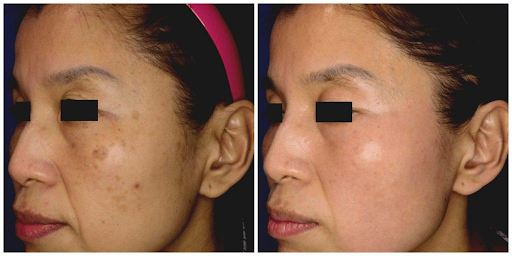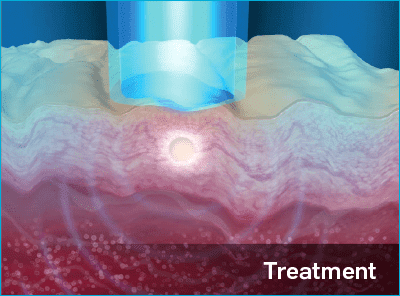
During pregnancy, your body undergoes various changes, and your skin is no exception. Melasma is a chronic hyperpigmentation condition caused by hormonal changes that result in overproduction of melanin. It usually starts in the mid-20s and can continue to affect individuals into their 60s and beyond. Unfortunately, traditional laser treatments can worsen melasma, but there’s hope in PicoSure laser technology for seeking How To Treat Pregnancy Melasma.
What Is Pregnancy Melasma?
Melasma, commonly referred to as “pregnancy mask,” is a specific form of skin hyperpigmentation that affects 50-75% of women during or after pregnancy. The condition is caused by an increase in estrogen levels and is identified by dark blotches on various areas of the face, including the forehead, cheeks, and lip areas.

Factors That Increase Your Chances of Developing Pregnancy Mask
Several factors increase the likelihood of developing melasma, including UV-ray exposure, hormones, being of child-bearing age, a physically active lifestyle, an increase in sun exposure, family history of melasma, increased female hormones from oral contraceptives or hormone replacement therapy, thyroid disease, and low testosterone. These are most of the reasons why someone would want to learn How To Treat Pregnancy Melasma via PicoSure Laser Technology.
Other factors that increase your risks of developing melasma during or after pregnancy include:
-Being of child-bearing age
-Thyroid disease
-Having low testosterone levels
-Having a physically active lifestyle
-Asian skin type (especially Fitzpatrick Skin Type III and IV)
-Increased exposure to the sun
-Having a family history of melasma
-Increased levels of female hormones from oral contraceptives or hormone replacement therapy



How To Treat Pregnancy Melasma: Melasma Treatment With PicoSure Laser
Fortunately, PicoSure laser treatments are an effective solution for melasma. PicoSure delivers short pressure waves into the skin, breaking down pigmentation into small particles that are absorbed and discarded by the immune system. Unlike traditional laser treatments, PicoSure does not produce heat, minimizing the risk of inflammation and triggering an increase in melasma.
PicoSure’s picosecond pulse is cell-signaling and produces significant rejuvenation to the treatment area, resulting in tighter, brighter skin. The treatment requires no downtime, making it a great option for all skin types.
Unlike topical creams, chemical peels, steroids, or oral treatments that can take months before seeing results, PicoSure provides faster and more predictable results. The treatment is quick, comfortable, and safe, with most sessions taking 30 minutes or less. If you have more questions about How To Treat Pregnancy Melasma don’t hesitate to call the professionals at Michelle’s Beauty & Wellness Center. They will be more than glad to answer each and every question you have about Pregnancy Melasma and PicoSure.

What New Mom’s Can Expect After Treatment
After treatment, the pigmentation may appear darker initially, but it will begin to fade over the next two weeks. We recommend an average of four treatments, 4-6 weeks apart, with maintenance appointments every six months.
If you’re struggling with pregnancy melasma, contact Michelle’s Beauty & Wellness Center to schedule a customized consultation appointment and learn more about how PicoSure laser treatments can improve your skin.
FAQ’s:
General FAQ’s
What is PicoSure?
PicoSure® is a groundbreaking picosecond aesthetic laser platform that offers various aesthetic treatments such as tattoo removal, acne scar treatment, removal of pigmented lesions, and wrinkle treatment. This advanced laser technology delivers ultra-short pulse bursts of energy to gently target and eliminate pigment without causing harm to the surrounding skin. With PicoSure, you can achieve a more youthful appearance by effectively removing pigment or treating wrinkles and acne scars.
Why choose PicoSure Laser Treatment?
When considering aesthetic treatments, it’s crucial to explore your options. Procedures like face-lifts, fillers, and toxins come with significant downtime, risks, and potential side effects. PicoSure laser treatment offers a non-invasive alternative with minimal downtime. It can be the first step towards achieving a more youthful appearance or addressing specific trouble areas. Contact our office today to find out if PicoSure laser treatment is the right choice for you.
Pigment FAQ’s
What causes unwanted pigment?
Unwanted pigment is caused by the concentration of melanin in specific areas of the skin. Melanin gives our skin its color. Sunspots, age spots, and brown patches appear dark because melanin is concentrated in those areas. Sun exposure is a common cause of pigmented lesions, although some people are born with them. Hormonal changes can also trigger changes in skin pigmentation.
Which types of pigmented lesions can PicoSure remove?
PicoSure can effectively remove various types of unwanted pigment. This includes age spots, freckles, and brown patches. During a complimentary consultation, your practitioner will assess your specific condition and develop a treatment plan to help you achieve pigment-free skin quickly.
How many treatment sessions are usually required?
Improving the appearance of your skin and achieving a more youthful look by removing pigmented lesions typically requires only a few treatments. However, darker, deeper, or larger pigmented lesions may require additional sessions. During the consultation, your practitioner will discuss the treatment expectations and tailor the plan accordingly.
What does the treatment feel like?
Most patients find the procedure tolerable and do not require numbing cream or anesthesia. PicoSure delivers energy in ultra-short bursts, often described by patients as a snap of a thin rubber band.
What type of post-treatment care is necessary?
After the procedure, the treated area may feel tender. It is important to keep the area clean and avoid any irritation. Your practitioner will provide specific aftercare instructions as needed to ensure a quick recovery.
Scar Treatment FAQ’s
How does laser scar treatment work?
Laser scar treatment utilizes ultra-short pulses of laser light to penetrate the skin’s sub-layers and target the support structure. This triggers the body’s natural healing process, which removes damaged tissue and stimulates the production of fresh collagen and elastin, essential components for normal-looking skin. The procedure is fast, simple, well-tolerated, and usually requires minimal downtime.
What types of scars can be treated?
Laser acne scar treatment is FDA-cleared for acne scars on any part of the body, including the face.
Am I a good candidate for this treatment?
Laser acne scar treatment can be effective for various skin types, including both light and darker skin tones. To determine if you are a suitable candidate, it is recommended to consult with a provider.
How many treatment sessions are usually required?
Achieving improved skin appearance and a more youthful look by removing acne scars generally requires a few treatments. However, darker, deeper, or larger scars may necessitate additional sessions. Your practitioner will discuss treatment expectations during the consultation and tailor a plan accordingly.
What does the treatment feel like?
Most patients find the procedure tolerable and do not require numbing cream or anesthesia. The energy delivered by PicoSure is in ultra-short bursts, often described by patients as a snap similar to that of a thin rubber band.
What type of post-treatment care is necessary?
After the procedure, the treated area may be sensitive. It is important to keep the area clean and avoid irritation. Your practitioner will provide additional aftercare instructions as needed to ensure a prompt recovery.
How many treatments will I need?
Improvement in acne scars typically begins to show after two treatments, although a series of three to five treatments is recommended for optimal aesthetic results.
How quickly will I recover?
Most people can resume regular activities immediately following the treatment session.
Are there any side effects?
Common side effects include temporary redness and swelling at the treatment site. The acne scarring may initially whiten during treatment, then darken over the next 24 hours before gradually shedding over time.
Wrinkle Treatment FAQ’s
How does the treatment work?
Our light-based treatments utilize advanced technologies to target all three layers of damaged tissue: epidermal pigment, mid-dermal wrinkles, and deep-dermal laxity. The body’s natural healing process then removes older tissue and stimulates the production of new collagen and elastin, essential for youthful-looking skin.
Am I a good candidate for this procedure?
If you have fine lines and wrinkles around your eyes, mouth, or other areas of your body, such as the face, hands, and arms, you may be a suitable candidate for the PicoSure treatment.
How long does the procedure take?
The treatment can be completed in as little as 15 minutes or less, depending on the size of the area being treated.
What does the treatment feel like?
Your treatment provider can offer measures to make the experience comfortable. As individual experiences may vary and depend on the required level of treatment, it is advisable to discuss all options with your laser treatment provider.
How many treatments will I need?
Typically, a series of 3-4 treatments is recommended. Treatment intervals are generally 2-4 weeks, but for darker skin types, it can extend up to 8 weeks. Each patient is unique and will undergo evaluation prior to treatment.
How quickly will I recover?
Temporary redness and swelling at the treatment site are common side effects that usually subside within an hour, but in some cases, they may persist for up to 24 hours.
Are there any side effects?
Possible adverse effects include hypopigmentation, hyperpigmentation, mild erythema, edema, and the risk of scarring and infection. By following the post-treatment care instructions provided by your practitioner, the risk of these adverse effects can be significantly minimized.
PicoSure Laser Tattoo Removal FAQ’s
How does PicoSure laser tattoo removal work?
The laser energy targets the tattoo ink, breaking it down into smaller particles that are eliminated by the body’s natural processes, leading to a lightening of the tattoo.
What does laser tattoo removal feel like?
The sensation during laser tattoo removal is often compared to getting a tattoo, but it is much faster. Your practitioner will work with you to ensure the best comfort option based on your individual situation.
How many treatments are needed for tattoo removal?
The number of laser treatments required for tattoo removal depends on various factors, such as ink type, tattoo size, location on the body, laser type, and lifestyle habits. During the consultation, a practitioner will assess your tattoo and recommend a realistic treatment plan for optimal results.
How frequently do I need treatments?
Typically, it takes 4-8 weeks for the body to absorb the ink particles, but every patient and tattoo responds differently. Following the recommended post-treatment protocol improves results and reduces the chance of adverse events.
How will my skin look after the laser treatment?
After the laser treatment, the ideal outcome is a slight whitening or “frosting” of the skin, which subsides immediately. Mild swelling and redness may also occur. Your practitioner will guide you on how to best care for the treated area.
I had previous laser treatment for my tattoo, but it didn’t clear. Why should I try again with PicoSure?
PicoSure has revolutionized tattoo removal. Unlike Q-Switched lasers, which use thermal energy, PicoSure delivers faster and more effective results due to its unique technology.
Can I lighten the tattoo to have another one done on top?
Yes, tattoos can be lightened in preparation for a cover-up tattoo. Your practitioner may recommend waiting six weeks between your last treatment and getting the new tattoo.
How much does tattoo removal cost?
The cost of laser tattoo removal depends on factors such as tattoo size and the number of treatments required. Insurance companies generally do not cover laser tattoo removal as it is considered an elective cosmetic procedure. After your consultation, your practitioner will provide an estimate for the treatment series.
Instructions on What To Do & Not Do After Pico Laser Treatment FAQ’s
After undergoing Pico laser treatment, it is important to follow these skincare tips:
Hydrate your skin: Drink plenty of water to maintain skin hydration. Use serums containing Hyaluronic Acid and Niacinamide to hydrate the skin.
Use recovery serums: Look for serums that contain stem cells, collagen, hyaluronic acid, and peptides to promote healing and recovery. These serums can be applied to ablated skin or used as a mask, especially for acne-prone skin.
Resume Vitamin C products: If your skin does not experience any irritation or stinging, you can continue using Vitamin C products. Vitamin C helps in skin healing and can be used as long as it doesn’t cause redness, pain, or irritation during application.
After Pico laser treatment, there are certain things to avoid:
Over-hydrating the skin: While it may seem tempting to apply more skincare products due to quicker absorption, over-hydrating with rich products can lead to acne breakouts and comedones, especially for individuals with sensitive or acne-prone skin.
Avoid using AHA products: For about 5-7 days after Pico laser treatment, refrain from using AHA products, especially if you experience redness or red petechial spots. Once your skin has fully recovered and returned to its baseline state, you can resume using AHA products.
Home – Schedule An Appointment – Featured Services – Monthly Specials – Gallery – Blog – Contact